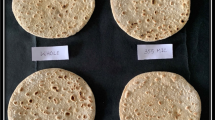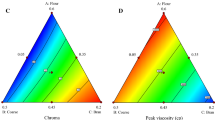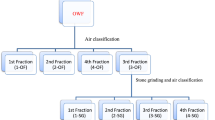Abstract
Fractionation (F-1, F-2, and F-3) of semi-dry milled rice flour (SDMRF) was performed using air-classification wheel speeds (ACWS, 1,000, 2,000, and 3,000 rpm) to identify suitable size fractions for preparation of gluten-free rice bread (GFRB). Characteristics and effects of fractions on GFRB were investigated. Fractions had higher water absorption indices than unfractionated flour (control). Fractions were smaller in size, and the amount of damaged starch was larger for higher ACWS values. The F-1 fraction had higher peak viscosities and specific volumes than other fractions. The F-3 fraction had lower values. GFRB prepared using the F-1 fraction had a lighter air-cell structure and lower hardness than control bread. From sensory evaluations, the particle size of SDMRF affected the appearance of GFRB. GFRB prepared using the F-1 fraction had more uniform and smaller air-cells. The quality of GFRB can be improved by controlling the particle size of flour.
Similar content being viewed by others

References
Arendt E. First international symposium on gluten-free cereal products and beverages: A great success. Cereal Food. World 53: 40–41 (2008)
Blanco CA, Ronda F, Perez B, Pando V. Improving gluten-free bread quality by enrichment with acidic food additives. Food Chem. 127: 1204–1209 (2011)
Rakkar PS. Development of a gluten-free commercial bread. MS thesis, Auckland University of Technology, Auckland, CA, USA (2007)
Paulus K. Quality of dietetic food-significance for human nutrition. LWT-Food Sci. Technol. 19: 147–151 (1986)
Schober TJ, Messerschmidt M, Bean SR, Park SH, Arendt EK. Gluten-free bread from sorghum: Quality differences among hybrids. Cereal Chem. 82: 394–404 (2005)
Demirkesen I, Mert B, Sumnu G, Sahin S. Rheological properties of gluten-free bread formulation. J. Food Eng. 96: 295–303 (2010)
Moroni AC, Bello FD, Arendt EK. Sourdough in gluten-free breadmaking: An ancient technology to solve a novel issue? Food Microbiol. 26: 676–684 (2009)
Yeh, A. Preparation and application s of rice flour. pp. 495–540. In: Rice Chemistry and Technology. Champagne ET (ed). American Association of Cereal Chemists, Inc., St. Paul, MN, USA (2004)
Bean MM, Elliston-Hoops EA, Nishita KO. Rice flour treatment for cake baking applications. Cereal Chem. 60: 445–449 (1983)
Song JY, Shin MS. Effects of soaking and particle sizes on the properties of rice flour and gluten-free RB. Food Sci. Biotechnol. 16: 759–764 (2007)
Kim SS, Kim DC, Lee SE, Kim WO, Kim H, Park JH. Development of Novel Rice Bakery Products with High Quality. Agricultural Research Promotion Center, Seoul, Korea. pp. 114–115 (2009)
de la Hera E, Martinez M, Gomez M. Influence of flour particle size on quality of gluten-free rice bread. LWT-Food Sci. Technol. 54: 199–206 (2013)
de la Hera E, Rosell CM, Gomez M. Effect of water content and flour particle size on gluten-free bread quality and digestability. Food Chem. 151: 526–531 (2014)
Park DJ, Ku KH, Mok CK. Characteristics of glutinous rice fractions and improvement of Yoogwa processing by microparticulation/air-classification. Korean. J. Food Sci. Technol. 27: 1008–1012 (1995)
Nishita KD, Bean MM. Grinding methods: The impact on rice flour properties. Cereal Chem. 59: 46–50 (1982)
AACC. Approved Methods of the AACC. 10th ed. Methods 08-01, 10-05, 10-15, 30-25, 44-15A, 46-12, 61-02, and 76-31. American Association of Cereal Chemists, St. Paul, MN, USA (2000)
Anderson RA. Water absorption and solubility and amylograph characteristics of roll-cooked small grain products. Cereal Chem. 59: 265–271 (1982)
Bourne MC. Texture profile analysis. Food Technol. 32: 62–72 (1978)
Inoue T, Osatake H. A new drying method of biological specimens for scanning electron micrography: The t-butyl alcohol freezedrying method. Arch. Histol. Cytol. 51: 53–59 (1988)
Stone H, Sidel JL. Descriptive analysis. pp. 201–246. In: Sensory Evaluation Practices. 3rd ed. Elsevier Academic Press, San Francisco, CA, USA (2004)
Kim YJ, Kim SS. Comparison of size distribution of rice flour measured by microscope, sieve, coulter counter, and aerodynamic methods. Korean J. Food Sci. Technol. 26: 184–187 (1994)
Moreita R, Chenol F, Torres MD, Prieto DM. Influence of the particle size on the rheological behavior of chestnut flour doughs. J. Food Eng. 100: 270–277 (2010)
Sapirstein HD, David P, Preston KR, Dexter JE. Durum wheat bread making quality: Effects of gluten strength, protein composition, semolina particle size, and fermentation time. J. Cereal Sci. 45: 150–161 (2007)
Marshall WE. Effect of degree of milling of brown rice and particle size of milled rice on starch gelatinization. Cereal Chem. 69: 632–636 (1992)
Kadan RS, Bryand RJ, Miller JA. Effects of milling on functional properties of rice flour. J. Food Sci. 73: 151–154 (2008)
Deffenbaugh LB, Walker CE. Comparison of starch pasting properties in the Brabender viscoamylograph and the rapid viscoanalyzer. Cereal Chem. 66: 493–499 (1989)
Park MK, Lee KS, Lee KH. Effect of rice powder particle size in baked rice breads. J. East Asian Soc. Dietary Life 18: 397–404 (2008)
Hoseney RC. Gluten Proteins. pp. 197–211. In: Principles of Cereal Science and Technology. 2nd ed. American Association of Cereal Chemists, Inc., St. Paul, MN, USA (1994)
Fredrick EJ. Effect of sorghum flour composition and particle size on quality of gluten-free bread. MS thesis, Kansas State University, Manhattan, KS, USA (2009)
Choi ID. Substitution of rice flour on bread-making properties. Korean J. Food Preserv. 17: 667–673 (2010)
Author information
Authors and Affiliations
Corresponding author
Rights and permissions
About this article
Cite this article
Park, J.H., Kim, D.C., Lee, S.E. et al. Effects of rice flour size fractions on gluten free rice bread. Food Sci Biotechnol 23, 1875–1883 (2014). https://doi.org/10.1007/s10068-014-0256-4
Received:
Revised:
Accepted:
Published:
Issue Date:
DOI: https://doi.org/10.1007/s10068-014-0256-4



